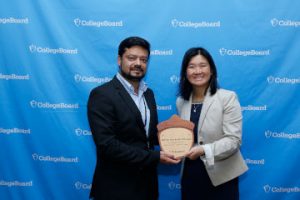All Management Events
- Egypt is the top destination for SRM AP AIESEC 2019 Internships April 26, 2019
SRM AP students will traverse the globe, to Egypt, Greece, Indonesia and Sri Lanka as part of AIESEC’s inaugural 6-8 week internships beginning May, 2019.
Aaditya Jain, one of five SRM AP representative members of AIESEC says, “The internships are structured to provide cross cultural experiences to students in more than 25 countries. This year, 10 of our students have been selected for two AIESEC programs – the Global Volunteer and Global Entrepreneur”.
Continue reading → - SRM University, AP Taps Global Alliance that Empowers Millions of Students April 25, 2019
New Delhi: Committed to empowering millions of students through expanding access to inter-disciplinary, inclusive, and tertiary education, SRM University, Andhra Pradesh, now joins College Board’s Indian Global Higher Education Alliance, to plug skills gaps and nurture global leaders. Driven by global collaboration and best practices, it accepts SAT score as part of admission processes.
Continue reading → - DIGITAL HUMANITIES: HOW TECHNOLOGY AND COMPUTATIONAL SCIENCE IS SHAPING THE FUTURE OF THE LIBERAL ARTS. April 24, 2019
 Dartmouth College, Hanover, New Hampshire: At Dartmouth’s April 2019 conference titled “The Marriage of Pre-Modern Literature and Computational Science” experts in the field of Digital Humanities, through a series of papers, will showcase new findings and insights on computational tools used to analyse their subjects, tools that have revolutionised research in the humanities. Three SRM Andhra Pradesh SLABS faculty: Dr. Prateek, Dr. Nibedita Bandyopadhyay and Dr. Rajni are attending the Dartmouth conference to enhance their knowledge of computational tools related to non-English languages, which in turn will allow them to advance their own digital humanities projects. Digital Humanities is a relatively new discipline where computer science and hermeneutics intersect to create new ways to expand traditional literary interpretation, particularly of older texts. The platform enables scholars to analyse global information on a piece of text or art using focused computational tools and thereby redefine the characteristics of the text.
Dartmouth College, Hanover, New Hampshire: At Dartmouth’s April 2019 conference titled “The Marriage of Pre-Modern Literature and Computational Science” experts in the field of Digital Humanities, through a series of papers, will showcase new findings and insights on computational tools used to analyse their subjects, tools that have revolutionised research in the humanities. Three SRM Andhra Pradesh SLABS faculty: Dr. Prateek, Dr. Nibedita Bandyopadhyay and Dr. Rajni are attending the Dartmouth conference to enhance their knowledge of computational tools related to non-English languages, which in turn will allow them to advance their own digital humanities projects. Digital Humanities is a relatively new discipline where computer science and hermeneutics intersect to create new ways to expand traditional literary interpretation, particularly of older texts. The platform enables scholars to analyse global information on a piece of text or art using focused computational tools and thereby redefine the characteristics of the text.As Dr. Prateek explains it – “Franco Moretti, a leader in the digital field first drew the distinction between closed readings (the traditional way to read a text) and distant readings where computational tools are applied to vast computer generated data on the text. In classic Gothic literature for example, a closed reading is likely to bring up imagery of cathedrals and labyrinths. However, a large data base of Gothic writings analysed by digital tools sheds new light, new ways to look at the text not thought of before – like word usage, language frequency, and other observations not commonly associated with Gothic literature. The focus here is not on language per se, rather how language is being used to evoke emotions associated with Gothic literature. This is where the digital medium helps as it is not always physically possible to analyse 200 texts on a wide range of criteria.”
Dr. Prateek’s interest in digital humanities began during his PhD in theatre studies at the University of Queensland in Australia when his supervisor, Prof. Joanne Tompkins with some of the leading figures in Ibsen Studies published A Global Doll’s House, a project for which she looked at 3787 productions of Ibsen’s Doll’s House worldwide. The database included the year of the production, the production company’s political affiliations, the prevalent political landscape of the time, casting, particularly of the lead character of Nora Helmer as performed in different countries and settings. This new approach alerted Dr. Prateek to the digital tools Prof. Tompkins employed for a new gender analysis of the text as well as to explain the impact of the prevalent political framework on the production house. “Prof. Tompkins’ project threw new light on Doll’s House in terms of restating the historical record of that time period. This scope of data analysis on a piece of text is beyond what one scholar can accomplish.”
As he set about looking for a text he could relate to for a similar exercise Dr. Prateek settled upon Kalidasa’s ‘Shakuntala’. “I had seen numerous productions of Shakuntala and was familiar with the usual arguments as to why the play should be produced – the view of it as a romantic comedy, the eco-criticism within the forest setting, and feminist leanings. Also, post 1947 when the theatre of roots emerged in India Shakuntala became very valid. For a theatre company to be legit it had to do Shakuntala. Yet, with all this history around Shakuntala and what it evoked I felt with the technology available in digital humanities new readings could emerge.”
Presently, Dr. Prateek is accumulating and building the database of Shakuntala productions worldwide. “In India, I know what kind of companies I am dealing with, like Habib Tanvir, Bhopal Naya Theatre. One aspect of this project is how the computational tools can simulate what theatre would have looked like in that time period – for instance, in 1789 when William Jones did the first English translation- if it was an expression of proscenium theatre or street theatre, also a funding analysis – government or private organisations.”
Dr. Prateek is anticipating the conference at Dartmouth will help single out the computational tool best suited for his subject, the database and the goals of the project. “There are many different kinds of computational tools and the conference will be an opportunity to see how different subjects are being treated, the different applications being used.”.
Drawing a clear distinction between new readings of primary text and the new knowledge that emerges from computational science’s engagement with humanities, Dr. Prateek says, “We are not looking for a new reading of the primary text. Rather a new way of looking at it, a historiography about the productions of the play that in turn can shed new light on the text.”
Dr. Nibedita Bandyopadhyay on Environmental Digital Humanities.
Continue reading → - BIOLOGY STUDENTS LAND PRESTIGIOUS INTERNSHIPS FOR RESEARCH AND STUDY April 17, 2019
SRM AP B.Sc. (Biology) students, Vasika Venugopal and Gowtham Gadupudi have landed prized internships with Jawaharlal Nehru Centre for Advanced Scientific Research and World Wildlife Fund.
 Vasika Venugopal will begin her summer at the Project Oriented Biological Education (POBE) an initiative of JNCASR, Bengaluru. Beginning May 2019 and for 3 consecutive years she will attend this esteemed fellowship for 2 months during the summer break. Meanwhile, around the same time, Gowtham Gadupudi’s begins his 1-month internship at WWF in Hyderabad.
Vasika Venugopal will begin her summer at the Project Oriented Biological Education (POBE) an initiative of JNCASR, Bengaluru. Beginning May 2019 and for 3 consecutive years she will attend this esteemed fellowship for 2 months during the summer break. Meanwhile, around the same time, Gowtham Gadupudi’s begins his 1-month internship at WWF in Hyderabad.The POBE project will enable Vasika to work in neuroscience and stem therapy (areas of interest to her) with an opportunity to have her work published in the JNCASR journal. The fellowship program awards a Diploma in Biology. Vasika will join a group of 11 candidates selected for this coveted program.
 Gowtham will report to the WWF State Director (who inspired him to apply during his visit to the SRM AP campus) during his internship tenure. Gowtham will develop biodiversity resource material on reptiles, amphibians, birds, and butterflies of Hyderabad as well as trees and foliage of Telangana and Andhra Pradesh. As part of his research, Gowtham will develop a database for the Wild Wisdom Quiz and write up research, proposals and reports.
Gowtham will report to the WWF State Director (who inspired him to apply during his visit to the SRM AP campus) during his internship tenure. Gowtham will develop biodiversity resource material on reptiles, amphibians, birds, and butterflies of Hyderabad as well as trees and foliage of Telangana and Andhra Pradesh. As part of his research, Gowtham will develop a database for the Wild Wisdom Quiz and write up research, proposals and reports.While Vasika will be exposed to research methodologies, Gowtham will gain practical experience within the global organization structure of WWF.
Continue reading → - “Our adoption of the Minerva Forum represents a leap forward in the use of interactive technology in which every single student is intensely engaged.” VC Jamshed Bharucha April 15, 2019

April, 2019: At the ASU GSV (Arizona State University/Global Silicon Valley) education summit in San Diego, SRM AP VC Jamshed Bharucha and Minerva’s Ben Nelson (serving on a panel entitled ‘Practical Solutions for Major Reform in Higher Education’) announced that the enhanced Minerva Forum will be offered to SRM AP’s students in the engineering and liberal arts. Ben Nelson explained how the scalable Forum platform improves educational outcomes for classes up to 400 students.Built upon seven years of development and decades of research into the science of learning, Minerva’s education system includes its pedagogy, intentionally scaffolded curriculum design, and proprietary Forum learning environment, designed to offer fully active learning classes in real time.
Ben Nelson, founder and CEO of Minerva pointed out that the system was designed with the specific goal of advancing the intellectual development of each student.
For SRM AP, the immediate benefit in adopting this platform – an intensive active-learning pedagogy using interactive technology – is that it establishes a stronger foundation in basic competencies like Expressive Clarity and Critical/Creative Thinking and Communication as well as other foundation courses. Subsequently, these fundamental cognitive processes will be extended onto courses across the curriculum.
SRM AP LEADERSHIP AT ASU GSV
Started in 2010 with a collaboration between Arizona State University and Global Silicon Valley (GSV), the annual summit focusses on learning and career outcomes. ASU GSV is regarded as the world’s leading education and workforce innovation summit. Also, at the summit this year, Nicholas Dirks, member of SRM AP Board of Governors and Honorary Pro Chancellor, served on a panel – The Coddling of the American Mind: Are Good Intentions Setting Up a Generation for Failure? Nicholas Dirks also gave a talk entitled StarTrek: The Global Context for the Reimagination of Education.
Continue reading → - SRM AP NOW A FOUNDING MEMBER OF THE COLLEGE BOARD’S INDIA GLOBAL HIGHER EDUCATION ALLIANCE April 12, 2019
At the recent College Board’s ‘India Global Higher Education Alliance’ symposium in Bangalore, SRM AP Director, Admissions Rupesh Bisht received the membership plaque from Linda Liu, Vice President, International, The College Board – the US based institution behind the SAT.

With this membership SRM AP joins a distinguished group of institutions in India and abroad (including Ashoka University, Columbia University and University of Cambridge) in adopting the SAT as a benchmark in the admissions processes. “As a founding member of the India Global Higher Education Alliance we will collectively shape the agenda of inclusivity and access to high quality higher education in India, says Rupesh Bisht. “SAT scores have proven predictive validity of student performance and we intend to use these as an admissions criterion in addition to our SRMJEEE test.”


At this event, leaders from the Alliance’s member universities gathered with prominent experts from the World Bank, Brookings India, Manipal Education Group and the Consortium for Higher Education Research in Asia (CHERA) to foster collaboration and the sharing of global best practices to advance access and excellence in higher education.
Some of the initiatives discussed: providing high quality education at the scale needed to meet India’s demands, increasing autonomy at leading universities, connecting university researchers to India’s national laboratories, the need to shift away from lecture-based classes to more project-based coursework and a call for institutions to put students at the top of their priority list.
https://international.collegeboard.org/india-global-alliance
Continue reading → - Dr. Sunil Chinnadurai April 9, 2019
- Dr. V Sateeshkrishna Dhuli April 4, 2019
- Dr Somesh Vinayak Tewari April 4, 2019
- Inter-disciplinary Curriculum is the Key to Improve Employability, says Dr. Jamshed Bharucha April 1, 2019
Dr. Jamshed Bharucha, Vice Chancellor, SRM University, AP Amaravati speaks to Namami Chakravarty about inter – disciplinary experimental active learning.
Q. What do you think are the sailent features of the reowned engineering programme of SRM, AP?
Our engineering programme, though only in its second year, is already recognized as a great programme and this is only because we believe in a multi-faceted and inter-disciplinary approach. We have a stellar faculty, 100% of which are Ph.Ds. with international education, teaching or industry exposure.
Continue reading →

